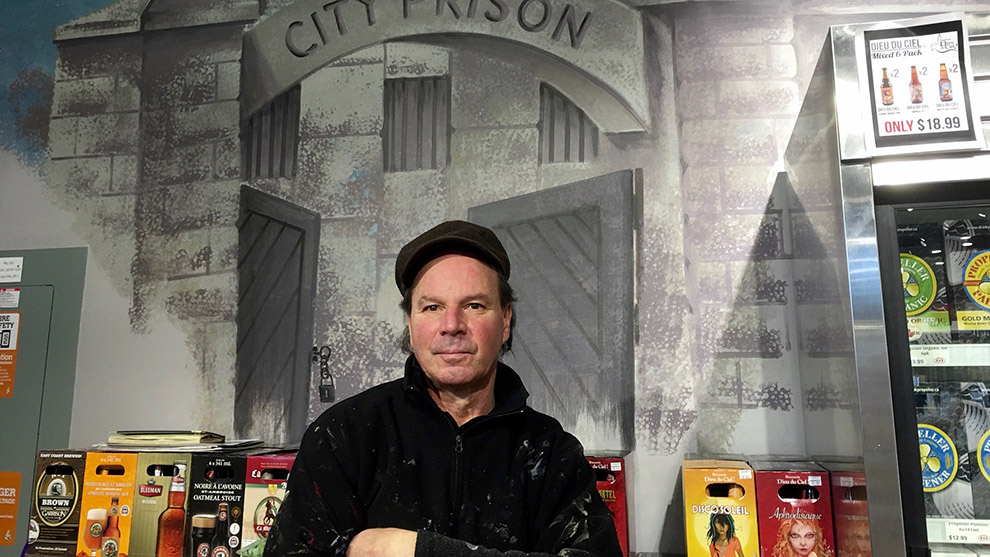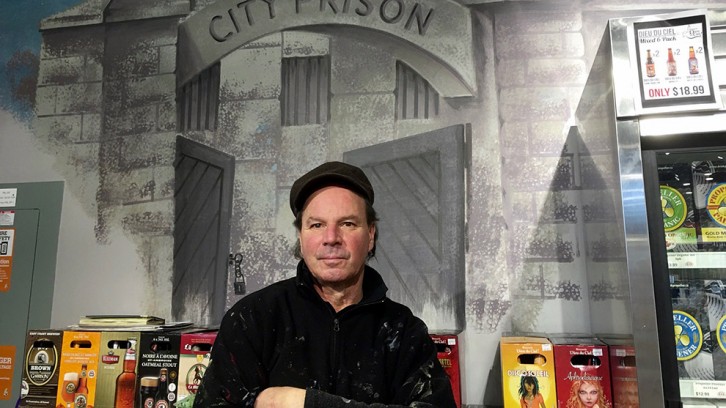Visual arts
Muralist brings community history to life
Bridgewater-based artist Peter Matyas has painted murals across Canada, including a new one at the RockHead Beer and Wine store

caption
Peter Matyas and his finished creation at the RockHead Wine and Beer Market.
caption
Peter Matyas and his finished creation at the RockHead Wine and Beer Market.Peter Matyas climbs down from atop a fridge displaying local beers and ciders at the RockHead Wine and Beer Market. He steps carefully down a ladder while wiping two wooden paintbrushes on his shirt — already decorated with smears of paint from past moments such as this.
Behind him stands a wall, recently blank, with the beginnings of a form made out in rough, hurried strokes of blue and grey. It’ll soon to be the sky and a concrete structure.
As he works, Matyas consults with employees of the market over colour and the potential addition of trees to the scene. For now, his top priority is getting the mural right.
Holding up a photograph, he judges his own work while inviting comments from the few spectators. The photo is of the Rockhead Prison, a Halifax institution that housed criminals serving time for mainly alcohol-related offences.
The building is set to rise again, immortalized on the back wall of the wine and beer market on Windsor Street.
Matyas is a muralist inspired by communities. Based in Bridgewater, N.S., the self-described cave painter works on projects far and wide, capturing the scenes, structures, moments and people that make each community what it is.
He calls it pure storytelling.
Matyas says he has communicated through art since he was a child. He was born in 1951 to a family that emigrated from Czechoslovakia through Pier 21 only two years earlier. English was not spoken in his home.
“My teachers in school thought I was deaf,” says Matyas. “I didn’t understand them.”
Matyas says he developed his own form of storytelling, passing notes with drawings to another classmate. He created his own language through imagery and symbolism — one he uses to this day.
After graduating from high school, Matyas made his living as a s ign painter outside of Vancouver. He briefly attended the Banff School of Fine Arts.
“There was no such thing as digital back then,” he says with a laugh. “It was all about real people doing real things. It still is for me.”
During his time painting signs, Matyas honed his artistic skills and learned to work for others rather than himself. His technique of painting letters has translated to his murals. Matyas says he always works from left to right, allowing for a natural flow and sense of light. He works with acrylic paints, which dry fast, to accommodate his quick pace when working on walls.
[idealimageslider id=”8349″]
Learning local history
What led Matyas into his current career, as he explains, is something that not even he saw coming.
“My partner Paul and I were strapped for cash when we saw a flyer looking for some mural work for a coffee shop. All we wanted was a cup of coffee so we took the job,” he says, pausing to laugh. “As we were painting, this man came up to us and asked if we could do a job for him as well. He said ‘I’ve got a grocery store.’”
That grocery store turned out to be the entire Loblaws corporation. The job turned out to be a 15-year tour for him, his partner and a small crew painting murals in 450 stores across eastern Canada.
Matyas and his crew were flown from large cities to small towns, working day and night to adorn the walls of the stores.
What went on the walls was up to them.
“What we decided to do seemed right,” says Matyas. “When we arrived in each town, we called a cab and told the driver to take us to the historical parts of the community.”
Matyas set out to embody the heart of each town on the walls of what he says are their lifelines — the markets where they get their food. Each mural featured real people from the community. Matyas says he painted everyone from the butcher and his son to the people shopping in the store. He even went as far as to seek input on the mural from local residents.
“They’re the ones who know it best,” says Matyas. “I’m a catalyst for their stories, that’s all I am.”
This is standard practice for Matyas now. Although on most jobs he is the lone painter, he says he never truly works alone.
Matyas has completed similar projects for other grocery stores, restaurants, municipalities and large companies.
He has sought work from business mogul Mickey MacDonald, owner of The Chickenburger, feeling that they shared many of the same values about community. The two have worked together on charity events to support youth in Halifax and other projects such as the newest mural at RockHead.
MacDonald says Matyas is a community man and a true people person.
“Years back, I bought The Chickenburger in order to keep it alive. Peter did a mural for me there,” says MacDonald. “As long as I own it, it will stay there.”
Just as Matyas works to capture the heart of each community, over time his murals have become integral to the culture of some of those towns.
With tears in his eyes, he says that in 2010, just 10 years after the completion of the Loblaws murals, crews were hired to paint over them in every store.
Matyas says the news was not taken well in Bridgewater.
“They got up there and refused to do it,” he says. “It was too important to their community. Loblaws management had to bring in new guys.”
Another mural completed by Matyas in 2006 on the Dartmouth Parclo wall was named one of the most notable landmarks in the area. At 230 metres long it’s the longest outdoor mural in Canada.
Bell Aliant commissioned Matyas to paint electrical cabinets throughout the Halifax Regional Municipality in an effort to prevent graffiti. This method has been adopted across Canada, according to Matyas.
As to the ubiquity of his work in public places, Matyas admits that it’s a bit odd having people know his work but not him. On the other hand, he says it’s a sign of having done the job he was supposed to do.
He works for the community, not for himself.
“If you do your job really well, no one will know that you did it,” says Matyas.
